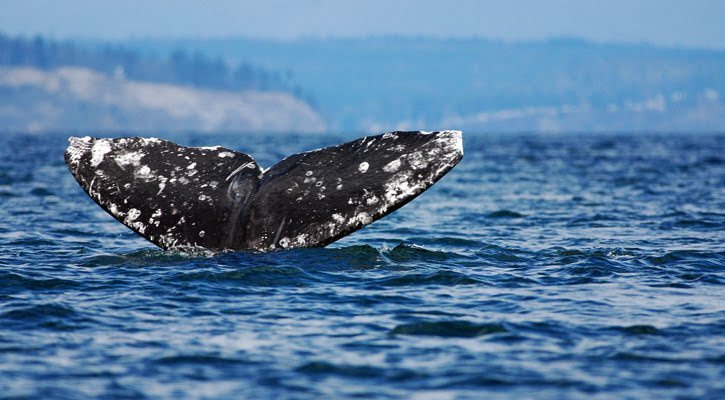Gray whales annually pass by the Peninsula twice each year, once on their migration from the Arctic to their wintering and breeding grounds in Southern California and Mexico and on the return trip from the southern climes.
Each winter Pacific Gray Whales pass by the Peninsula after spending the summer feeding in the food-rich waters of the Arctic. Heading south along the Pacific coast to the bays of Baja California, where they mate and nurse their young, you can witness the annual winter journey.
Early January is the peak of the migration, but whales can be spotted mid-December through early February. The heights around the Lewis and Clark Interpretive Center and North Head Lighthouse offer the best viewing. Bring binoculars if you have them.
The northward migrations begin mid-March. The immature whales, adult males, and females without calves are the first to head north, passing the Peninsula in March and April. Later, females with calves come along at a slightly slower rate, passing the Washington coast in May.
How to Whale Watch
Choose a location
Find a spot like North Head, where the land juts into the ocean and there is plenty of elevation. The North Head Lighthouse and Lewis and Clark Interpretive Center are excellent choices. Both are located in Cape Disappointment State Park, so a Discover Pass is required.
Choose a time
Pick early morning hours when conditions are usually more favorable prior to the onset of winds and their accompanying whitecaps.
Choose weather that favors a calm ocean. Don’t go during or just after a heavy storm. Overcast days are good because there is little glare.
What to look for
Scan the horizon and look for the blow, the whale’s vapor, water or condensation is blown up to 12 feet in the air when the whale exhales.
Once a blow is located, stay with it. Where one blow is viewed, others will follow either from the same whale or others.
Whales have periodic blow patterns during their migration, making up to a half dozen short, shallow dives before a prolonged dive of up to 10 minutes (more generally 3 to 5 minutes).
Frequently, the animals leave turbulent eddies along the surface after short dives.
Usually, only a small portion of the whale’s head and back show during a blow. Diving whales, where the rear fin (fluke) is exposed, or breaching, where the whale jumps nearly completely out of the water, are quite rare.
Whale Watching Terminology
Breaching
75% of the body vertically rises out of the sea. If you see this once it should be repeated several times, so keep your eyes peeled.
Spy Hopping
The head arises vertically from the sea. The whale is literally taking a peek at what’s above water.
Blow, Plume or Spout
A mist 6 to 12 feet in height as the whale exhales. You will note the blow every 1 or 2 minutes at 100-yard intervals 3 or 4 times, then often you will see the flukes (tail fins) as the whale prepares for a deeper dive. These dives frequently last 3 to 10 minutes or longer.
Gray Whale Facts
- Grays have existed for approximately 10 million years.
- The whales travel at about 6 miles per hour.
- The spring migration is north to the Bering and Chukchi seas to feed. The winter migration is to the warm waters of Southern and Baja California for breeding and giving birth. The total distance is about 5,500 miles.
- After a gestation period of 13 months, the calves weigh almost 2,000 pounds at birth and are 15 feet long. They nurse for about eight months.
- Gray whales have an average lifespan of 50 years. Although considered a medium-sized baleen whale, they grow to between 40 and 50 feet in length and attain weights of 30 to 40 tons.
- Baleen is a filtering substance much like a fingernail. Whale baleen filters scoop up water and retain food. Gray whales do not have teeth and eat bottom dwellers: beach hopper-like animals, worms, and little clams.
- In the past 135 years, the Gray has been hunted to near extinction twice but has once again reached a population of about 23,000 animals. These are the only grays left on earth and have been protected since 1946.
- These animals are thought to be poor navigators and travel close to the shore during migration in water no deeper than 300 feet though more often in water only 20 to 30 fathoms (120-180 feet).
- Although they do not sing, the Grays do emit grunts, moans and short bursts of a “bong-bong-bong” sound. Grays have good vision also though their habitat is extremely murky.






